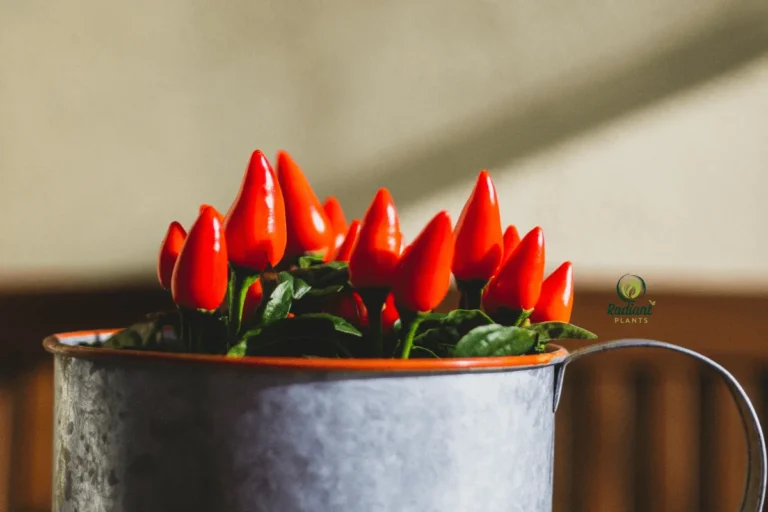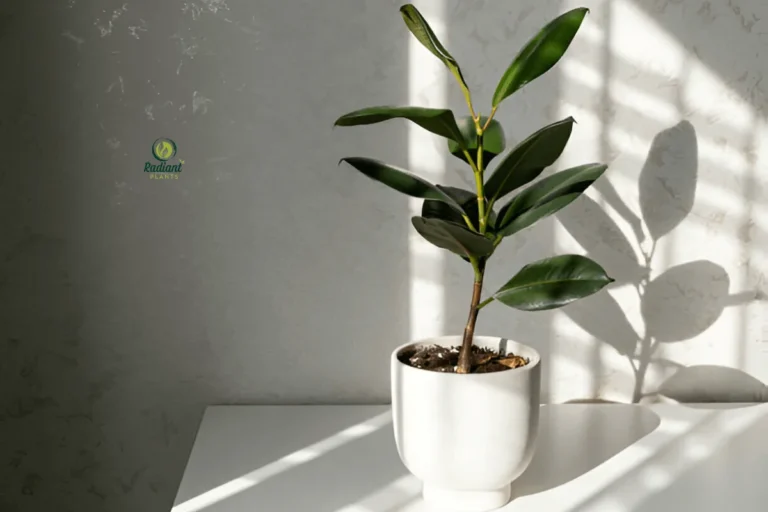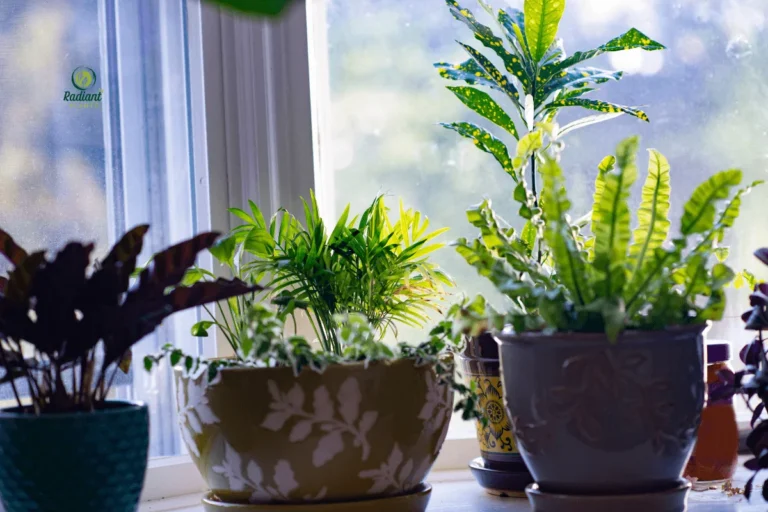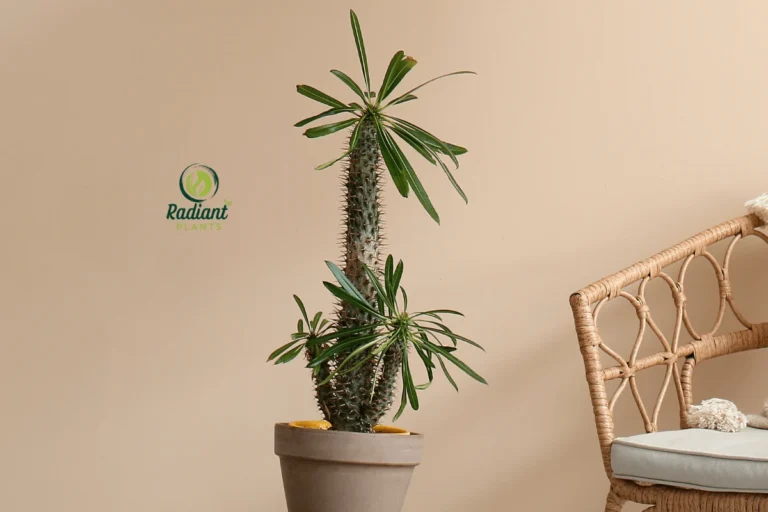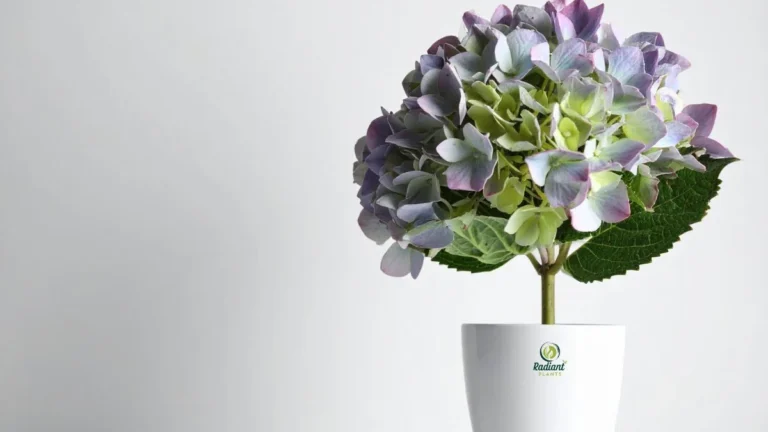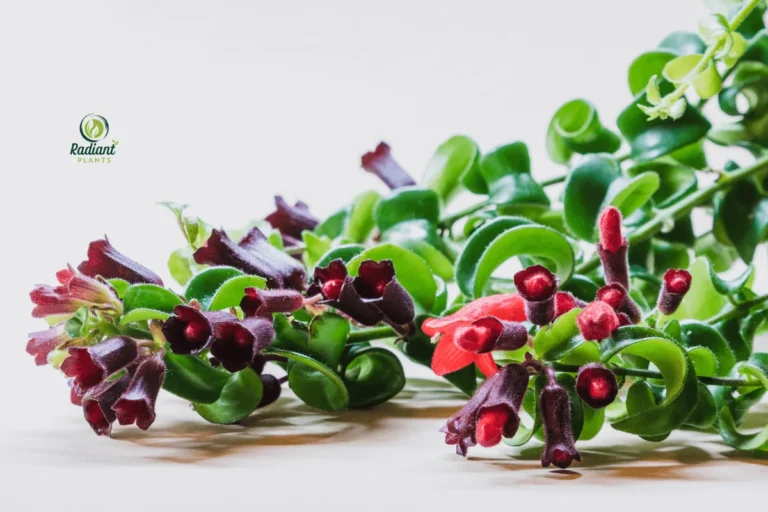Indoor Tree Plants: A Simple Guide for New Plant Parents
Indoor tree plants are the perfect way to bring life, color, and clean air into your home—especially for new plant parents. These leafy companions are surprisingly low-maintenance and can adapt to a range of indoor conditions, making them ideal for beginners.
Whether you’re working with a sunlit corner or a small shaded nook, there’s an indoor tree plant that fits your space and lifestyle. In this guide, we’ll help you choose the right tree, understand its care needs, and avoid common mistakes—so you can grow with confidence from day one.
Table of Contents
Table of Contents
Why Indoor Tree Plants Are Perfect for Beginners
![Low-maintenance [Indoor Tree Plants] like Rubber Plant in bright modern living room](https://www.radiantplants.com/wp-content/uploads/2025/07/Why-Indoor-Tree-Plants-Are-Perfect-for-Beginners-1024x683.webp)
Snippet-style answer:
Indoor tree plants are ideal for new plant parents because they offer low-maintenance care, visual appeal, and air-purifying benefits—all while thriving in a variety of indoor environments. With the right choice, even beginners can enjoy a lush, green home without stress.
Easy to Maintain, Big Visual Impact
One of the biggest reasons indoor tree plants are so beginner-friendly is their forgiving nature. Unlike fussy houseplants that wilt at the first missed watering, many indoor trees are naturally resilient. They adapt well to indoor climates, tolerate occasional neglect, and don’t require advanced gardening skills to thrive.
But their simplicity doesn’t mean they’re boring. These plants deliver bold visual impact—filling corners, brightening empty walls, and adding natural elegance to any space. A single well-placed tree can anchor a room’s design, turning a bland corner into a vibrant focal point.
Some low-maintenance options include:
- Rubber Plant (Ficus elastica) – thrives in medium light, tolerates infrequent watering.
- Parlor Palm (Chamaedorea elegans) – great for low light and small spaces.
- Dracaena Marginata – stylish, drought-tolerant, and tall with minimal care.
Natural Air Purifiers and Mood Boosters
Another reason indoor tree plants are excellent for beginners is their dual benefit: they enhance both air quality and emotional well-being. Studies show that indoor plants can reduce stress, increase productivity, and even promote a sense of calm.
Many tree-like houseplants are also known to filter airborne toxins such as formaldehyde and benzene. In compact apartments or rooms with limited airflow, this natural purification can make a noticeable difference.
Some trees with notable air-purifying properties include:
- Areca Palm – humidifies and cleans indoor air.
- Fiddle Leaf Fig – large leaves trap dust and absorb toxins.
- Corn Plant (Dracaena fragrans) – filters common household chemicals.
🌱 Beginner-Friendly Benefits at a Glance
Here are 5 key reasons why indoor trees are great for first-time plant owners:
Benefit | Why It Helps Beginners |
|---|---|
Low Maintenance | Tolerates missed waterings and basic lighting |
Visual Impact | Fills space with minimal effort or accessories |
Air Purification | Improves indoor air without machines |
Stress Reduction | Proven to boost mood and reduce anxiety |
Pet-Friendly Options Available | Several choices safe for pets and children |
💡 Tip: Start with one easy-care plant and observe how it responds. Once you build confidence, you can expand your indoor jungle.
Recap
Indoor tree plants are ideal for new plant parents because they require minimal upkeep, enhance your home’s atmosphere, and deliver visual charm with minimal effort. From air-purifying power to space-enhancing beauty, these plants are more than just decoration—they’re a healthy, beginner-proof habit you’ll love growing into.
5 Best Indoor Tree Plants for First-Time Growers
![Low-maintenance [Indoor Tree Plants] like Rubber Plant in bright modern living room](https://www.radiantplants.com/wp-content/uploads/2025/07/Indoor-Tree-Plants-1024x683.webp)
These indoor tree plants are low-maintenance and great for first-time growers. They offer beauty, adaptability, and stress-free care—all ideal for beginners.
Choosing the right indoor tree plants can feel overwhelming, but the good news is that many varieties are both visually appealing and easy to care for. Whether you’re looking for a bold statement piece or a modest green companion, the following trees are beginner-tested favorites.
These indoor tree plants are low-maintenance and ideal for those just starting their plant journey, offering flexibility in terms of light, watering, and care needs.
🌿 Fiddle Leaf Fig (Ficus lyrata)
Beloved for its broad, violin-shaped leaves, the Fiddle Leaf Fig is a modern design icon. It thrives in bright, indirect light and enjoys consistent moisture.
- Light: Bright, indirect
- Water: Keep soil moist, but not soggy
- Style Tip: Great for corners or next to windows
- Beginner Note: Can be picky about placement, but manageable with basic care
🌿 Rubber Plant (Ficus elastica)
This hardy plant is known for its thick, glossy leaves and adaptable nature. It’s a fast grower and tolerant of a range of indoor conditions.
- Light: Medium to bright
- Water: Let the top inch of soil dry between watering
- Beginner Tip: A great first plant—resilient and forgiving
- Bonus: Adds height and drama without much effort
🌿 Areca Palm (Dypsis lutescens)
The Areca Palm brings a tropical vibe to any room and works well in bright spaces. Its feathery fronds can reach several feet tall indoors.
- Light: Bright, indirect
- Water: Water when the top 2 inches feel dry
- Air Quality Boost: Acts as a natural humidifier
- Safe for Pets: Yes! One of the safest tall indoor tree plants
🌿 Money Tree (Pachira aquatica)
Known for its braided trunk and symbolism of good fortune, the Money Tree is a popular gift and an excellent beginner plant.
- Light: Bright, indirect
- Water: Allow soil to dry between waterings
- Beginner Friendly: Resists overwatering and low humidity
- Pet Safety: Non-toxic to cats and dogs
🌿 Corn Plant (Dracaena fragrans)
Low light? No problem. The Corn Plant is highly tolerant and great for darker rooms or offices. Its upright leaves resemble corn stalks—hence the name.
- Light: Low to medium
- Water: Every 1–2 weeks, depending on room temperature
- Maintenance: Wipe leaves to remove dust
- Note: Not safe for pets (mild toxicity)
📊 Comparison Table: Top 5 Indoor Tree Plants
Plant Name | Light Needs | Watering | Pet Safe? | Max Height |
|---|---|---|---|---|
Fiddle Leaf Fig | Bright, indirect | Keep soil moist | No | 6–10 feet indoors |
Rubber Plant | Medium–bright | Allow top inch to dry | No | Up to 8 feet |
Areca Palm | Bright, indirect | When top 2 inches are dry | ✅ Yes | 6–7 feet |
Money Tree | Bright, indirect | Let the soil dry between waterings | ✅ Yes | 6–8 feet |
Corn Plant | Low–medium | Every 1–2 weeks | No | 4–6 feet |
🌱 Pro Tip: Rotate your plant occasionally so it grows evenly toward the light.
These indoor tree plants are low-maintenance and great for small apartments, home offices, and anyone new to plant care. Their resilience and beauty make them long-term companions as you build confidence and green up your space.
15 Indoor Trees To Grow In Pot | Big Trees To Grow Indoor | Big Indoor Tree | Indoor Plants
How to Choose the Right Indoor Tree Plant for Your Space
![Lighting needs for [Indoor Tree Plants] from bright windows to low-light corners](https://www.radiantplants.com/wp-content/uploads/2025/07/How-to-Choose-the-Right-Indoor-Tree-Plant-for-Your-Space-1024x683.webp)
When selecting indoor tree plants, always think about your space’s light, size, and safety needs. The right match will thrive with minimal effort and look great year-round.
Finding the perfect indoor tree plant isn’t just about aesthetics—it’s about creating a match between the plant’s needs and your living conditions. When selecting indoor tree plants, always think about three key factors: light availability, room size, and whether you have pets or children. This ensures your plant will thrive and your home stays safe and stylish.
🌤 Consider Lighting Conditions
Light is one of the most critical elements in determining a plant’s success indoors. Some indoor tree plants flourish in bright, indirect light near a sunny window, while others tolerate low-light corners.
Before picking a plant, take note of your space:
- Bright indirect light: Rooms with south- or west-facing windows.
- Medium light: Rooms that get filtered or partial light for a few hours.
- Low light: North-facing rooms or spots far from windows.
💡 Tip: Use your phone’s compass to check window orientation and get a sense of how much sun the area receives.
Best picks by light level:
- Bright light: Fiddle Leaf Fig, Areca Palm
- Medium light: Rubber Plant, Money Tree
- Low light: Corn Plant, Parlor Palm
🪴 Match Tree Size to Room Size
Big trees make bold statements—but if you’re short on space, they can feel overwhelming. Likewise, small trees might look out of place in a large open-plan area.
Think about:
- Ceiling height: Most indoor trees grow 4–10 feet indoors.
- Room traffic: Avoid placing large trees where people walk or near doorways.
- Container size: Taller plants need larger, heavier pots for stability.
Size-matching suggestions:
- Small rooms (bedrooms, studios): Money Tree, Parlor Palm
- Medium rooms (offices, kitchens): Rubber Plant, Corn Plant
- Large rooms (living areas, foyers): Fiddle Leaf Fig, Areca Palm
🪟 Style Tip: Tall slender plants work well in corners, while bushier types can define open space.
🐾 Pet and Child Safety Considerations
Many indoor tree plants look beautiful but may be toxic to pets or young children if ingested. This is especially important for cats and dogs, who often nibble on greenery.
When selecting indoor tree plants, always think about who shares the space with you. Prioritize non-toxic varieties if safety is a concern, and avoid placing potentially harmful plants at floor level.
Safe picks for pet- and kid-friendly homes:
- ✅ Money Tree
- ✅ Areca Palm
- ✅ Bamboo Palm
- ✅ Kentia Palm
⚠️ Avoid: Fiddle Leaf Fig, Rubber Plant, and Corn Plant if your pets are curious chewers.
🌿 Quick-Reference List: Tree Picks by Need
Condition | Top Tree Picks |
|---|---|
Low Light | Corn Plant, Parlor Palm |
Small Spaces | Money Tree, Rubber Plant |
Pet/Kid Safe | Areca Palm, Money Tree, Kentia Palm |
Large Rooms | Fiddle Leaf Fig, Areca Palm |
Matching the right tree to your home makes all the difference. When selecting indoor tree plants, always think about your lighting, layout, and household safety. It not only helps your plant thrive but makes plant care less of a chore and more of a joy.
Caring for Indoor Tree Plants: The Essentials
![Watering routine for [Indoor Tree Plants] using the soil-check method](https://www.radiantplants.com/wp-content/uploads/2025/07/Caring-for-Indoor-Tree-Plants-The-Essentials-1024x683.webp)
Caring for indoor tree plants doesn’t have to be complicated. With the right watering habits, environmental conditions, and quick responses to issues, even beginners can grow healthy, thriving trees indoors.
If you’re just starting your plant parent journey, don’t worry—caring for indoor tree plants is easier than it seems. Most species are resilient, and with a little attention to routine care, your green friends will thrive for years. From watering to troubleshooting leaf drop, the essentials come down to consistency and observation
💧 Watering Routine Made Easy
Overwatering is one of the most common mistakes new plant owners make. Most indoor tree plants prefer their soil to dry out slightly between waterings, though exact needs vary by species.
General watering tips:
- Stick your finger 1–2 inches into the soil. If it feels dry, it’s time to water.
- Always use pots with drainage holes.
- Water less in winter when plants grow more slowly.
- Avoid letting the plant sit in standing water—it can cause root rot.
Tree Type | Watering Frequency |
|---|---|
Fiddle Leaf Fig | Weekly (check soil first) |
Rubber Plant | Every 7–10 days |
Areca Palm | Every 5–7 days |
Money Tree | Every 1–2 weeks |
Corn Plant | Every 10–14 days |
🌱 Tip: Use room-temperature water to avoid shocking the roots.
☀️ Light, Temperature, and Humidity Tips
The environment plays a big role in the health of your tree. While most indoor tree plants adapt well to indoor climates, small adjustments can help them flourish.
Light:
- Bright, indirect light is ideal for most varieties.
- Avoid direct afternoon sun—it can scorch leaves.
- Rotate your plant every week to promote even growth.
Temperature:
- Aim for a range between 65–75°F (18–24°C).
- Avoid cold drafts near windows or AC vents.
Humidity:
- Most indoor trees prefer moderate humidity (40–60%).
- Use a humidity tray, room humidifier, or mist the leaves occasionally.
🛠️ Common Issues and How to Fix Them
Even healthy trees can run into trouble now and then. Luckily, most problems have simple fixes if caught early.
Troubleshooting guide:
Issue | Possible Cause | Solution |
|---|---|---|
Yellowing leaves | Overwatering | Let soil dry out; check pot drainage |
Brown leaf tips | Low humidity or tap water salts | Increase humidity; switch to filtered water |
Dropping leaves | Sudden light/temp changes | Move gradually to new spot; reduce stress |
Stunted growth | Not enough light or nutrients | Move to a brighter location; consider fertilizing |
❓ FAQs About Indoor Tree Plant Care
How often should I water indoor tree plants?
It depends on the plant type and your home’s environment. Most trees need water once a week or when the top inch of soil feels dry. Always check before watering to avoid overwatering.
Why are my indoor tree plants dropping leaves?
Sudden leaf drop usually means your plant is stressed—commonly from changes in light, temperature, or watering habits. Try to keep conditions stable and move plants gradually if relocating them.
Caring for indoor tree plants doesn’t have to be complicated. With the right rhythm of watering, awareness of environmental needs, and a little patience, your indoor tree will grow into a healthy and beautiful part of your home.
Styling Tips: Make Your Indoor Tree a Design Statement
![Stylish planter ideas for [Indoor Tree Plants] including baskets, ceramics, and mid-century stands](https://www.radiantplants.com/wp-content/uploads/2025/07/Styling-Tips-Make-Your-Indoor-Tree-a-Design-Statement-1024x683.webp)
Indoor tree plants not only freshen the air, but also transform your home’s interior. With the right pots, placement, and styling, these leafy giants become living décor.
Beyond their natural beauty and air-purifying powers, indoor tree plants are powerful design elements. Whether you live in a cozy apartment or a sprawling modern home, a well-placed indoor tree can anchor a space, create balance, or simply soften the mood with greenery. Indoor tree plants not only freshen the air, but also add personality and a sense of calm to your interior.
🪴 Best Pots and Planter Ideas
Choosing the right container is just as important as choosing the right plant. Your pot or planter should complement both your plant’s size and your home’s aesthetic.
Functional tips:
- Always choose a planter with drainage holes.
- Use a saucer or inner plastic pot to catch excess water.
- Match pot size to plant height—bigger trees need deeper bases for balance.
Styling ideas:
- Woven Baskets: Add warmth and texture (great for Boho or Scandinavian spaces).
- Terracotta Pots: Classic, breathable, and perfect for rustic interiors.
- Mid-Century Planters: Sleek and modern—ideal for Fiddle Leaf Figs.
- Ceramic Pots with Stands: Great for lifting smaller trees and making them more visible.
- Concrete or Matte Black Pots: Best for minimal, industrial-style spaces.
🎨 Tip: Neutral-toned pots work well with vibrant green foliage and prevent visual clutter.
🪟 Where to Place Your Tree for Maximum Impact
Strategic placement enhances both your décor and your plant’s health. You want to highlight your indoor tree without creating crowding or blocking pathways.
High-impact placement ideas:
- Living Room Corners: Frame a sofa or brighten up a dull corner.
- Next to Entryways: Welcome guests with greenery and freshness.
- By Large Windows: Let the light shine through the leaves—ideal for light-loving trees.
- Beside Desks or Reading Nooks: Adds calm and improves concentration.
- Bathroom (with windows): Certain palms and ferns thrive in humidity-rich environments.
Space-enhancing tricks:
- Use trees to visually balance a tall bookshelf or opposite a large piece of wall art.
- Group a tall tree with smaller plants for a layered effect.
- Reflect the plant with a nearby mirror to double its visual impact.
📸 Pinterest-Worthy Styling Examples
Use these design concepts as visual inspiration to turn your indoor tree into a stunning home feature:
- Modern Minimalist: A tall Rubber Plant in a white ceramic pot, placed in a sunlit corner of a minimalist living room with wood floors and white walls.
- Boho Chic: Areca Palm in a woven seagrass basket, surrounded by floor cushions, string lights, and layered rugs.
- Scandinavian Cozy: Money Tree on a light wood stand, nestled beside a gray armchair and knit throw blanket.
- Urban Jungle Vibe: Multiple indoor trees like Fiddle Leaf Fig and Corn Plant, combined with hanging pothos and trailing vines in a bright loft space.
- Spa-Inspired Bathroom: Parlor Palm in a sleek planter near a freestanding tub, next to rolled towels and scented candles.
🖼️ Style Tip: Mix plant textures (broad leaves vs. feathery fronds) to add depth and contrast to your layout.
Indoor tree plants not only freshen the air, but also offer a flexible and stylish way to express your personality through décor. With a thoughtful pot and the right placement, your tree can become the heart of the room—both living and elevating the space around it.
Mistakes to Avoid as a New Indoor Tree Plant Parent
Many new plant parents struggle with indoor tree plants due to common mistakes like overwatering, poor placement, and ignoring early warning signs. Avoiding these errors makes plant care much easier and more rewarding.
Starting your journey with indoor tree plants is exciting—but like any new skill, there’s a learning curve. Many new plant parents struggle with indoor tree plants due to simple but avoidable mistakes. From watering missteps to choosing the wrong plant for your space, a little awareness can go a long way toward keeping your greenery healthy and thriving.
💦 Overwatering and Poor Drainage
This is the most common reason beginners lose their indoor trees. While it may seem like more water = more growth, too much water suffocates the roots and leads to root rot, a silent killer for houseplants.
What to avoid:
- Watering on a strict schedule without checking the soil
- Using decorative pots with no drainage holes
- Letting plants sit in saucers full of excess water
Quick fixes:
- Use your finger to test soil moisture (dry 1–2 inches deep? Time to water).
- Use a well-draining potting mix formulated for indoor plants.
- Always choose pots with proper drainage holes.
🌿 Pro Tip: Many indoor tree plants prefer to be slightly underwatered than soaked.
🚪 Wrong Tree for Wrong Room
Not all trees thrive everywhere. One of the biggest beginner mistakes is picking a plant that doesn’t match the room’s light, humidity, or space constraints. A Fiddle Leaf Fig, for example, will struggle in a dark hallway, while a palm might hate dry office air.
Before choosing a tree, ask:
- Does this room get bright, indirect light?
- Is it humid or dry (e.g., bathroom vs. living room)?
- Is there enough vertical and horizontal space?
Avoid this mistake by:
- Researching care needs before buying
- Matching your plant’s light and space requirements to your room’s conditions
- Starting with flexible, low-maintenance species like Money Trees or Rubber Plants
🐛 Ignoring Pest Signs
Pests may seem like an outdoor problem, but indoor tree plants are just as vulnerable—especially in warm, dry rooms. Spider mites, scale, and fungus gnats are common uninvited guests.
What to watch for:
- Sticky residue on leaves
- Yellowing or curling leaf edges
- Fine webbing under leaves
- Tiny bugs flying near the soil surface
How to prevent and treat:
- Wipe leaves regularly to remove dust and pests
- Check new plants for bugs before bringing them home
- Treat infestations early with neem oil, insecticidal soap, or natural remedies like diluted rubbing alcohol
🧽 Tip: A monthly “plant spa day” helps prevent both pests and general decline.
❌ Top 5 Beginner Mistakes with Indoor Tree Plants
Mistake | Why It Happens | How to Avoid It |
|---|---|---|
Overwatering | Confusing care with excess | Check soil before watering |
Poor Drainage | Using pots without holes | Use pots with drainage & saucers |
Placing in Low-Light Areas | Not assessing light needs | Choose low-light trees for dark spaces |
Ignoring Pests | Not checking under leaves or soil | Inspect weekly and clean regularly |
Choosing the Wrong Tree Type | Picking based on looks alone | Match tree to space and lifestyle needs |
Many new plant parents struggle with indoor tree plants due to a lack of understanding—something that’s completely normal and easy to correct. With a bit of planning and observation, you can avoid the most common pitfalls and create a thriving indoor garden you’ll be proud of.
❓ FAQs About Indoor Tree Plants
What are the easiest indoor tree plants to care for?
Beginner-friendly indoor tree plants include rubber plant, money tree, and parlor palm—they tolerate low light and inconsistent watering well.
How often should I water indoor tree plants?
It varies by plant and environment, but generally water when the top 1–2 inches of soil are dry—often every 1–2 weeks for most indoor trees.
Can indoor tree plants improve indoor air quality?
Yes! Many indoor tree plants—like Areca Palm and Fiddle Leaf Fig—help filter pollutants and increase humidity, improving your home’s air.
Are indoor tree plants safe for pets and children?
Not all—some, like fiddle leaf figs and rubber plants, can be toxic. Opt for pet-safe varieties such as money trees, areca palms, or bamboo palms.
Why are my indoor tree plants dropping leaves?
Leaf drop often signals stress. It’s usually caused by overwatering, sudden light changes, or drafts. Stabilize their environment and adjust care gently.
Final Thoughts + Quick-Start Checklist
With the right steps, your indoor tree plants will thrive—even if you’re a complete beginner. All it takes is the right match, a bit of care, and a touch of style.
Starting with indoor tree plants may feel intimidating at first, but the journey is far more forgiving than most people expect. These leafy companions don’t just beautify your space—they help reduce stress, improve air quality, and connect you to the rhythm of nature indoors.
If you’ve followed along through this guide, you’ve already learned how to choose the right tree, care for it with confidence, and style it to suit your home. Now, it’s time to turn that knowledge into action.
With the right steps, your indoor tree plants will thrive—and so will your confidence as a new plant parent.
✅ Quick-Start Checklist: Getting Started with Indoor Tree Plants
Step | Action | Notes |
|---|---|---|
1 | Pick your tree | Choose from beginner-friendly trees like Money Tree, Areca Palm, or Rubber Plant |
2 | Assess lighting | Use a phone compass to determine window direction; bright indirect light works for most |
3 | Pot it right | Use a breathable container with drainage holes and high-quality indoor potting mix |
4 | Water wisely | Check soil 1–2 inches deep before watering; avoid overwatering |
5 | Place thoughtfully | Choose a spot with suitable light and visibility—your tree is part of your décor |
6 | Monitor health | Look for signs like yellowing leaves or pests, and act quickly |
7 | Adjust as needed | Rotate your tree occasionally and tweak watering with seasons |
🌿 Bonus Beginner Tips
- Start slow: One plant is all you need to build confidence.
- Observe weekly: A five-minute check-in can prevent most issues.
- Keep tools handy: A small watering can, a moisture meter, and a microfiber cloth are all you need to start.
- Celebrate growth: Even a new leaf is a victory!
💬 Remember: Indoor tree plants thrive when their environment is stable. Try not to move them too frequently, and always introduce changes (like more light or less water) gradually.
With the right steps, your indoor tree plants will thrive and reward you with years of growth, greenery, and joy. Every new leaf is a reflection of your care—and every plant you nurture brings you closer to nature, one root at a time.

![Lighting needs for [Indoor Tree Plants] from bright windows to low-light corners](https://www.radiantplants.com/wp-content/uploads/2025/07/How-to-Choose-the-Right-Indoor-Tree-Plant-for-Your-Space.webp)
